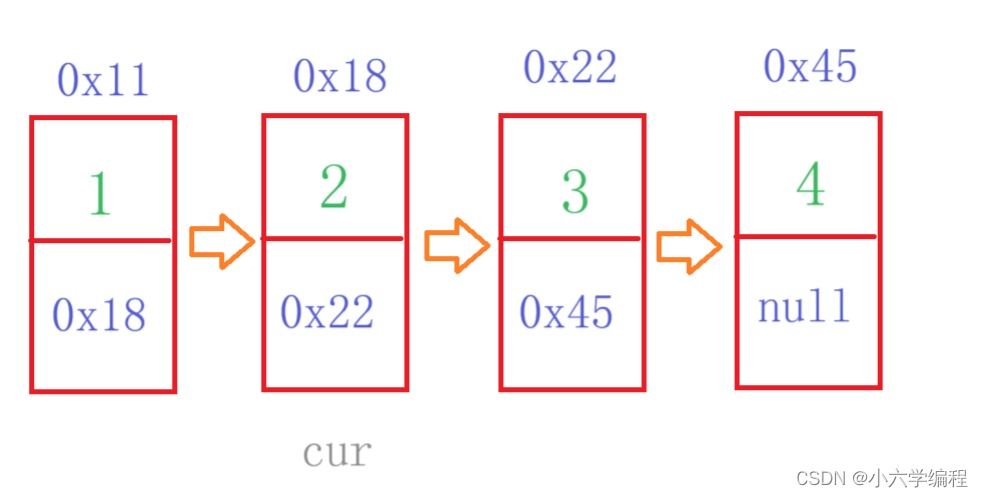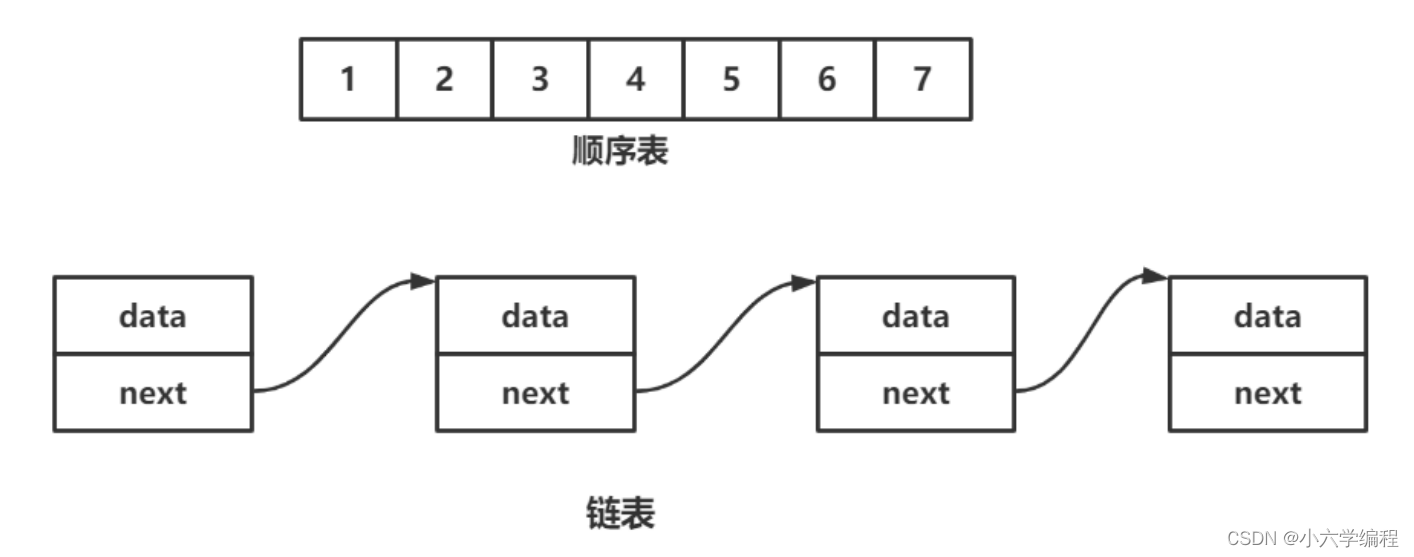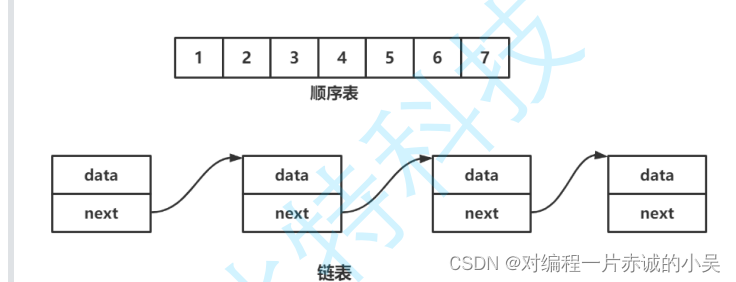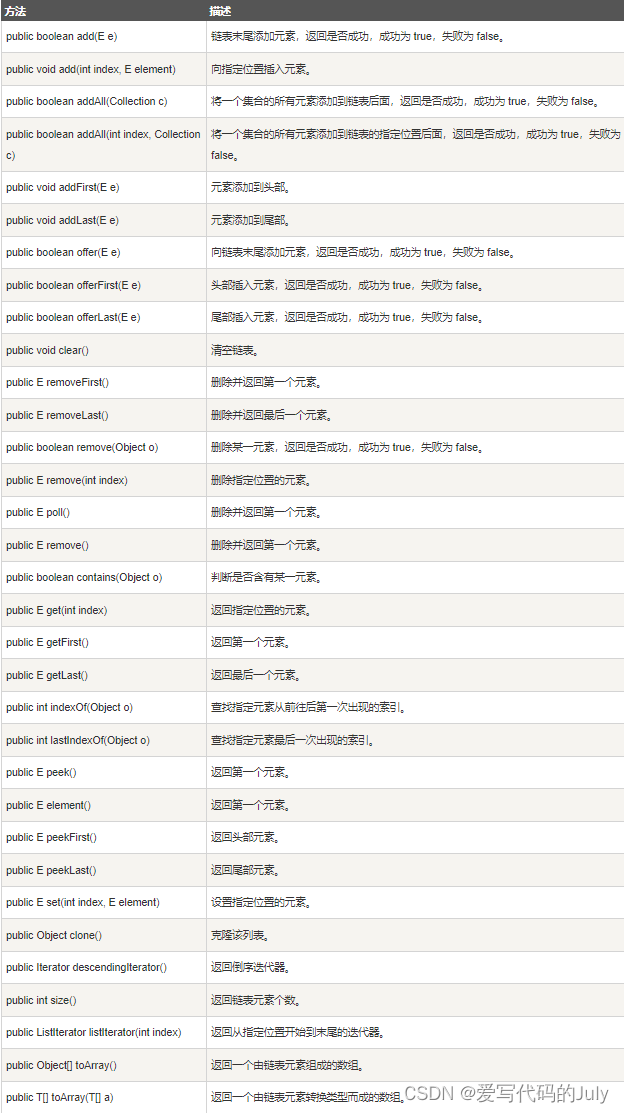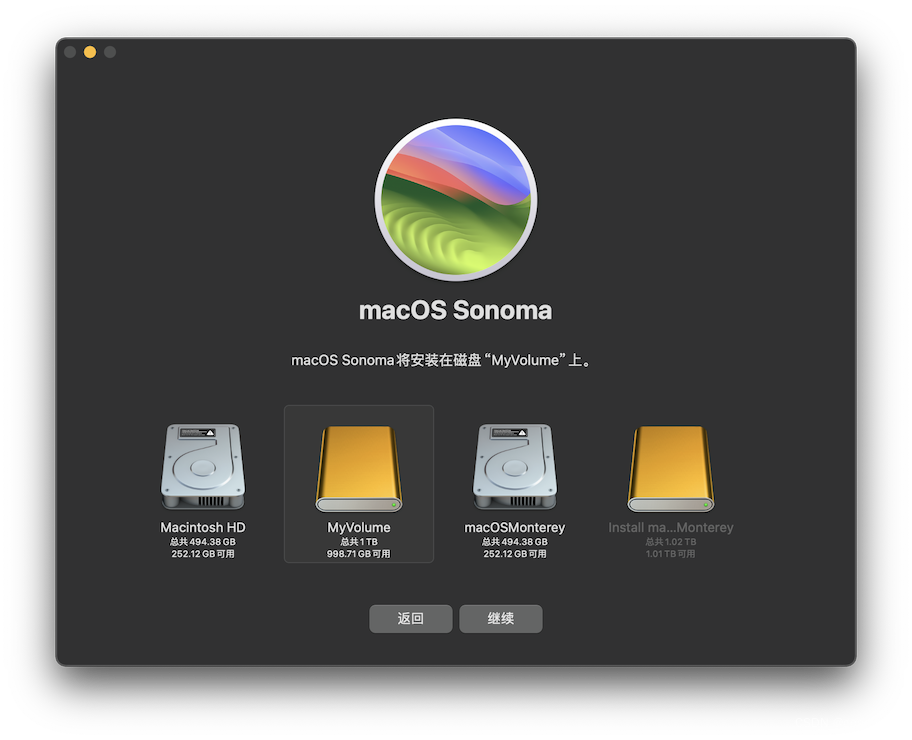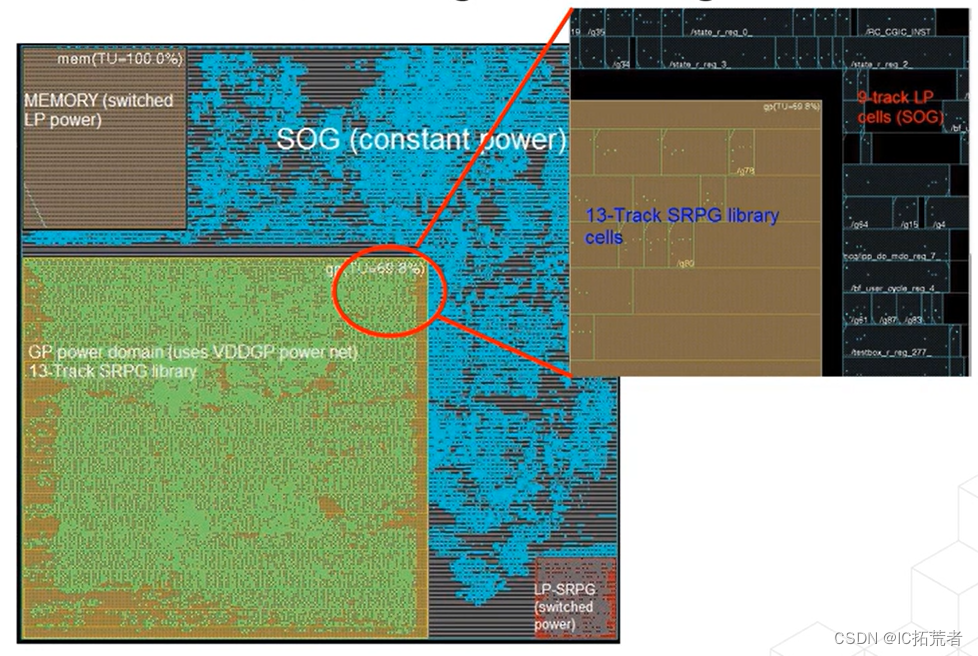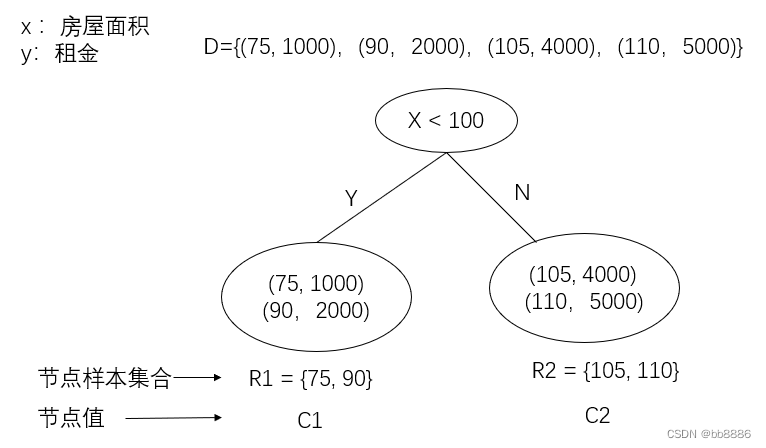目录
3.给定一个带有头结点 head 的非空单链表,返回链表的中间结点。如果有两个中间结点,则返回第二个中间结点
5.将两个有序链表合并为一个新的有序链表并返回。新链表是通过拼接给定的两个链表的所有节点组成的
6.编写代码,以给定值x为基准将链表分割成两部分,所有小于x的结点排在大于或等于x的结点之前
一,顺序表表/ArrayList的缺陷
在上期我们已经熟悉了ArrayList的使用,并且进行了简单模拟实现。通过源码我们知道ArrayList底层使用数组来存储元素。
二,链表
如果说顺序表其底层在物理意义上是一段连续的空间,那么链表便是是一种物理存储结构上非连续存储结构,数据元素的逻辑顺序是通过链表中的引用链接次序实现的 。
顺序表是一段连续不可分的空间:

链表像一列火车一样,多个节点被串成一块具有连续性意义的结构,实际上各个节点都来自于不同的地址:








三,链表的实现
和上期顺序表一样,我们采用接口的方式实现:
接口部分:
// 1、无头单向非循环链表实现
public interface IList {
//头插法
public void addFirst(int data);
//尾插法
public void addLast(int data);
//任意位置插入,第一个数据节点为0号下标
public void addIndex(int index,int data);
//查找是否包含关键字key是否在单链表当中
public boolean contains(int key);
//删除第一次出现关键字为key的节点
public void remove(int key);
//删除所有值为key的节点
public void removeAllKey(int key);
//得到单链表的长度
public int size();
//清空链表
public void clear();
//打印链表
public void display();
}接口方法实现:
public class AchieveList implements IList{
static class ListNode {
public int val;
public ListNode next;
public ListNode(int val) {
this.val = val;
}
}
public ListNode head;
//创建一个链表
public void crateList() {
ListNode node1 = new ListNode(12);
ListNode node2 = new ListNode(34);
ListNode node3 = new ListNode(56);
ListNode node4 = new ListNode(78);
ListNode node5 = new ListNode(99);
node1.next = node2;
node2.next = node3;
node3.next = node4;
node4.next = node5;
this.head = node1;
}
//头插法
@Override
public void addFirst(int data) {
ListNode node =new ListNode(data);
node.next = this.head;
this.head = node;
}
//尾插法
@Override
public void addLast(int data) {
ListNode cur = this.head;
while (cur.next != null) {
cur = cur.next;
}
ListNode node = new ListNode(data);
cur.next = node;
}
//任意位置插入,第一个数据节点为0号下标
@Override
public void addIndex(int index, int data) {
ListNode node = new ListNode(data);
ListNode cur = this.head;
ListNode prev = this.head;
if (index == 0) {
node.next = cur;
this.head = node;
} else {
int count = 0;
while (count != index) {
cur = cur.next;
count++;
}
count = 0;
while ((count+1) != index) {
prev = prev.next;
count++;
}
node.next = cur;
prev.next = node;
}
}
//查找是否包含关键字key是否在单链表当中
@Override
public boolean contains(int key) {
ListNode cur = this.head;
while (cur != null) {
if (cur.val == key) {
return true;
}
cur = cur.next;
}
return false;
}
//删除第一次出现关键字为key的节点
@Override
public void remove(int key) {
if (head == null) {
return;
}
ListNode cur = this.head;
ListNode prev = this.head;
int count = 1;
while (cur.val != key) {
if (count == size()) {
return;
}
cur = cur.next;
count++;
}
if (count == 1) {
head = null;
head = prev.next;
} else {
while (prev.next.val != key) {
prev = prev.next;
}
prev.next = cur.next;
}
}
//删除所有值为key的节点
@Override
public void removeAllKey(int key) {
ListNode cur = this.head;
int count = 1;
while (cur.next != null) {
if (cur.val == key) {
count++;
}
cur = cur.next;
}
for (int i = 0; i < count; i++) {
remove(key);
}
}
//得到单链表的长度
@Override
public int size() {
int count = 1;
ListNode cur = this.head;
if (cur == null) {
return 0;
}
while (cur.next != null) {
cur = cur.next;
count++;
}
return count;
}
@Override
public void clear() {
ListNode cur = this.head;
while (cur.next != null) {
head = null;
head = cur.next;
cur = cur.next;
}
head = null;
}
//打印链表
@Override
public void display() {
ListNode cur = this.head;
if (head == null) {
System.out.println("[" + "]");
} else {
System.out.print("[");
while (cur != null) {
if (cur.next == null) {
System.out.println(cur.val + "]");
} else {
System.out.print(cur.val + " ");
}
cur = cur.next;
}
}
}四,与链表有关的题目练习(1)
1.删除链表中等于给定值 val 的所有节点
class Solution {
public ListNode removeElements(ListNode head,int val) {
if (head == null) {
return null;
}
ListNode cur = head.next;
ListNode prev = head;
while (cur != null) {
if (cur.val == val) {
prev.next = cur.next;
cur = cur.next;
} else {
cur = cur.next;
prev = prev.next;
}
}
if (head.val == val) {
head = head.next;
}
return head;
}
}2.反转一个单链表
思路:
现有如下链表:
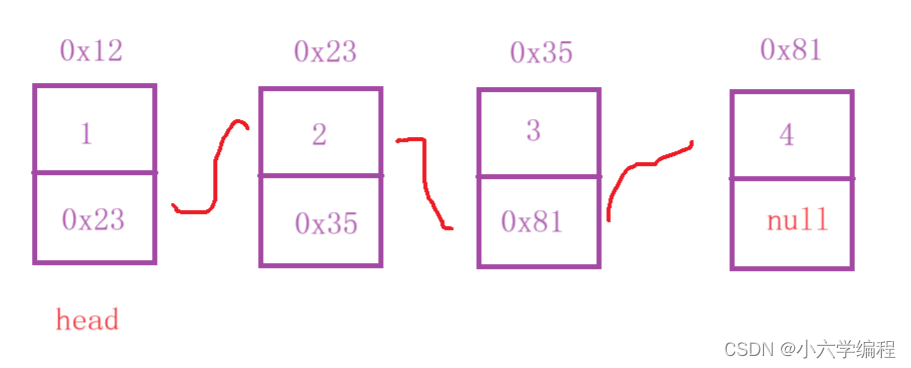
定义cur = head.next

将head.next指向null

定义变量curNext = cur.next

将cur的下一个节点设为head
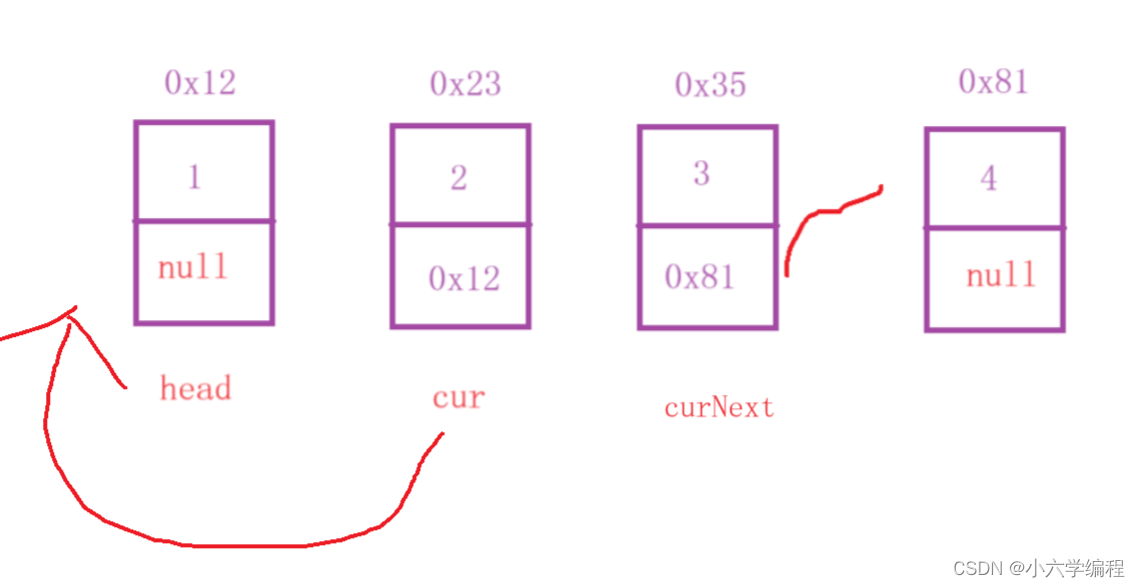
令cur = curNext;curNext = cur.next;
后以此思路循环
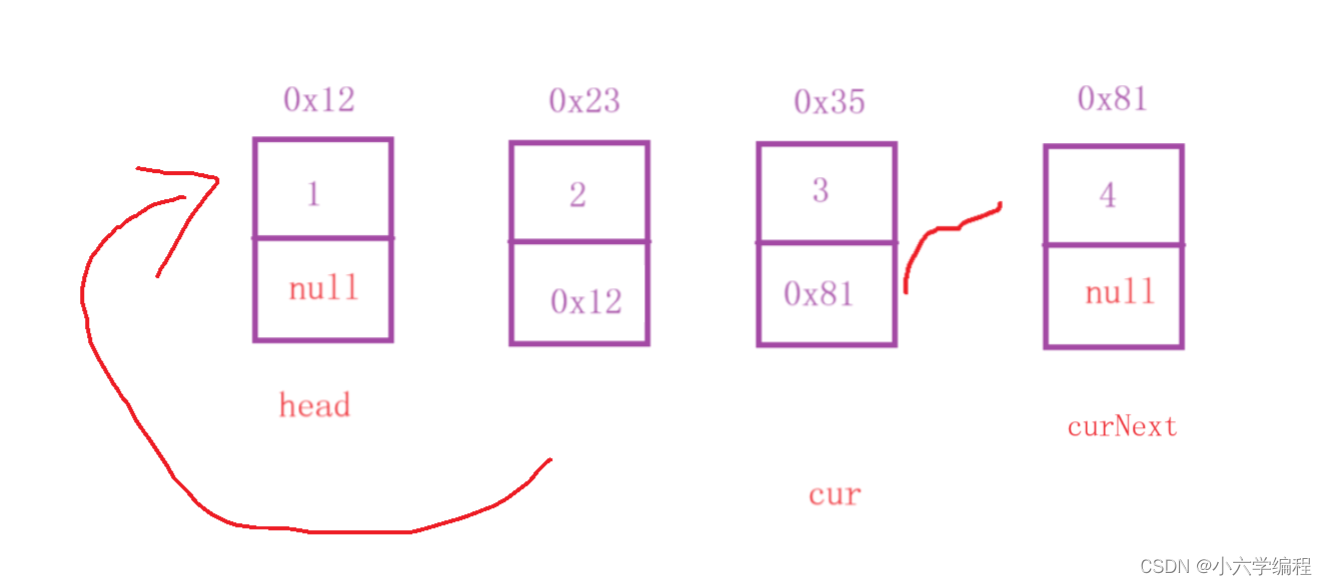
class Solution {
public ListNode reverseList(ListNode head) {
if (head == null) {
return null;
}
if (head.next == null) {
return head;
}
ListNode cur = head.next;
head.next = null;
while (cur != null) {
ListNode curNext = cur.next;
cur.next = head;
head = cur;
cur = curNext;
}
return head;
}
}3.给定一个带有头结点 head 的非空单链表,返回链表的中间结点。如果有两个中间结点,则返回第二个中间结点
思路:
定义如图两个变量fast和slow,且都等于head
令fast每次走两步,slow每次走一步。当fast==null或者fast.next === null时
此时slow的位置必定是中间节点
初:
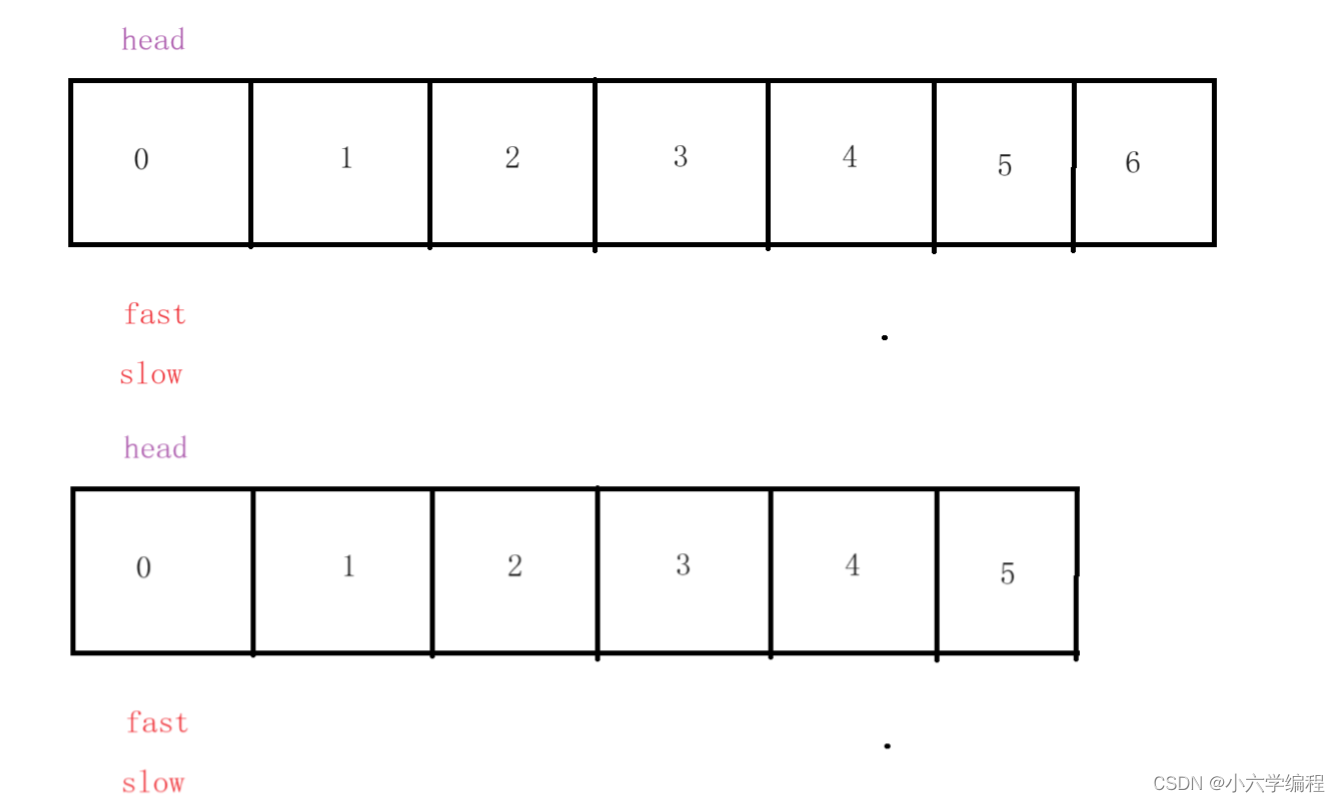
移动一次:
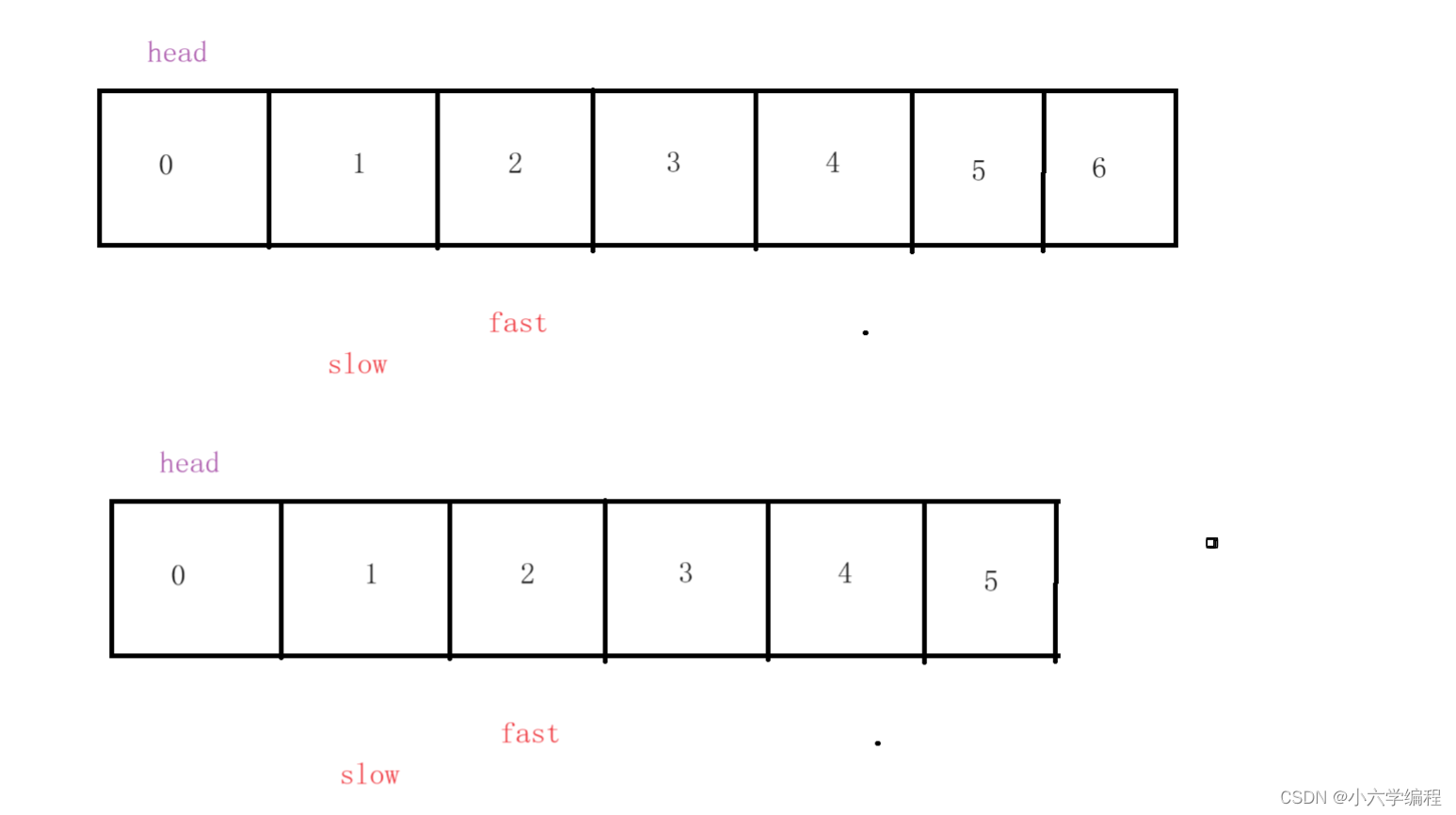
移动两次:
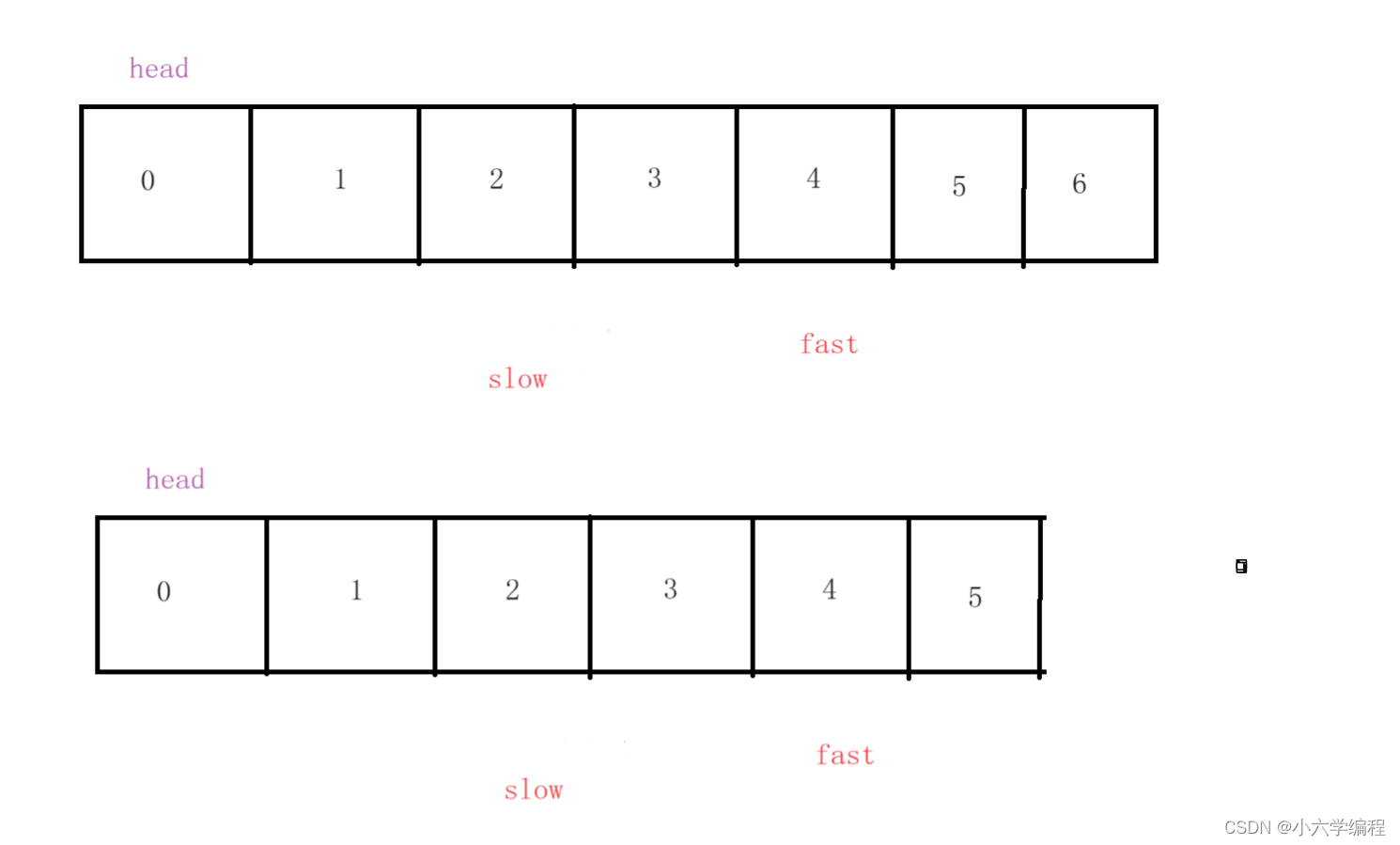
末:

class Solution {
public ListNode middleNode(ListNode head) {
ListNode fast = head;
ListNode slow = head;
while (fast != null && fast.next != null) {
fast = fast.next.next;
slow = slow.next;
}
return slow;
}
}
}4.输入一个链表,输出该链表中倒数第k个结点
假设有以下链表:

要求倒数第k个节点,我们可以先定义fast和slow两个位于头节点的变量
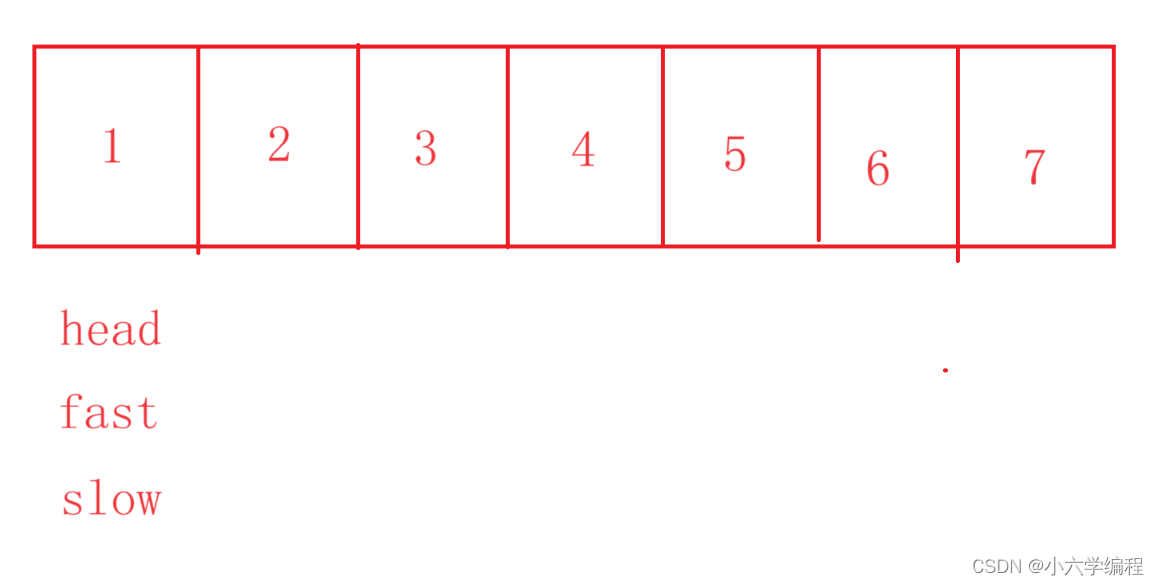
假如K为3,我们就先令fast先走K-1步

然后令fast和slow一起走同样的步数,直到fast.next为null
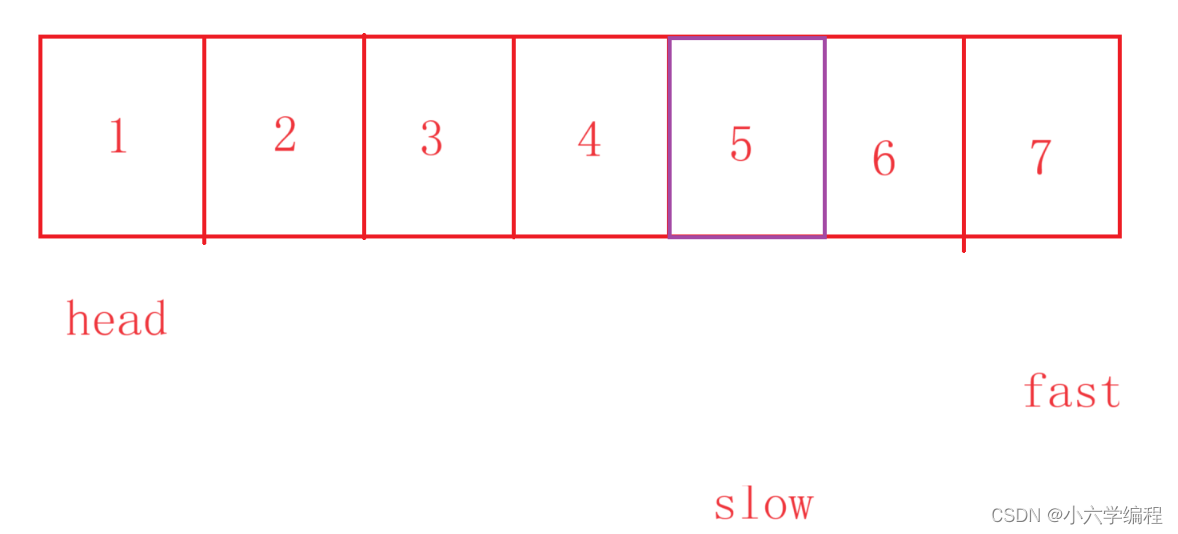
此时slow对应的位置就是所求的倒数第K个节点
public class Solution {
public ListNode FindKthToTail(ListNode head,int k) {
if (head == null) {
return head;
}
if (k <= 0 && head != null ) {
return null;
}
ListNode fast = head;
ListNode slow = head;
for (int i = 0; i < k-1; i++) {
fast = fast.next;
//处理K太大的问题
if (fast == null) {
return null;
}
}
while (fast.next != null) {
fast = fast.next;
slow = slow.next;
}
return slow;
}
}5.将两个有序链表合并为一个新的有序链表并返回。新链表是通过拼接给定的两个链表的所有节点组成的
思路:
先有以下两个有序链表需要被合并为一个有序链表

定义一个newH节点

将head1.val与head2.val进行比较,较小令它等于tmpH且令它等于它的下一个节点,tmpH为newH的下一个节点
如上图head1.val<head2.val,故发生以下变化

接着对head1.val与head2.val进行比较
head2.val更小
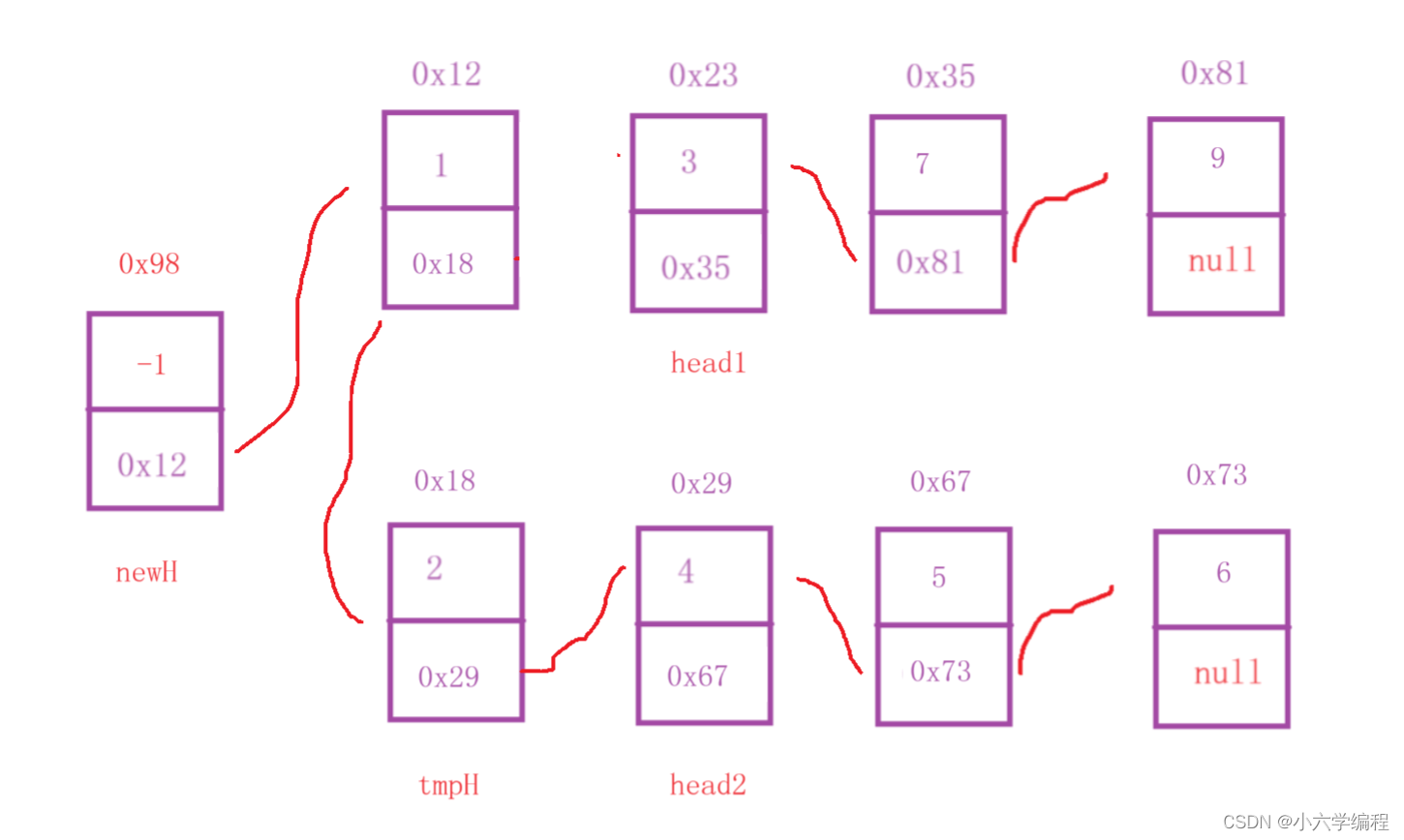
继续比较
head1.val更小
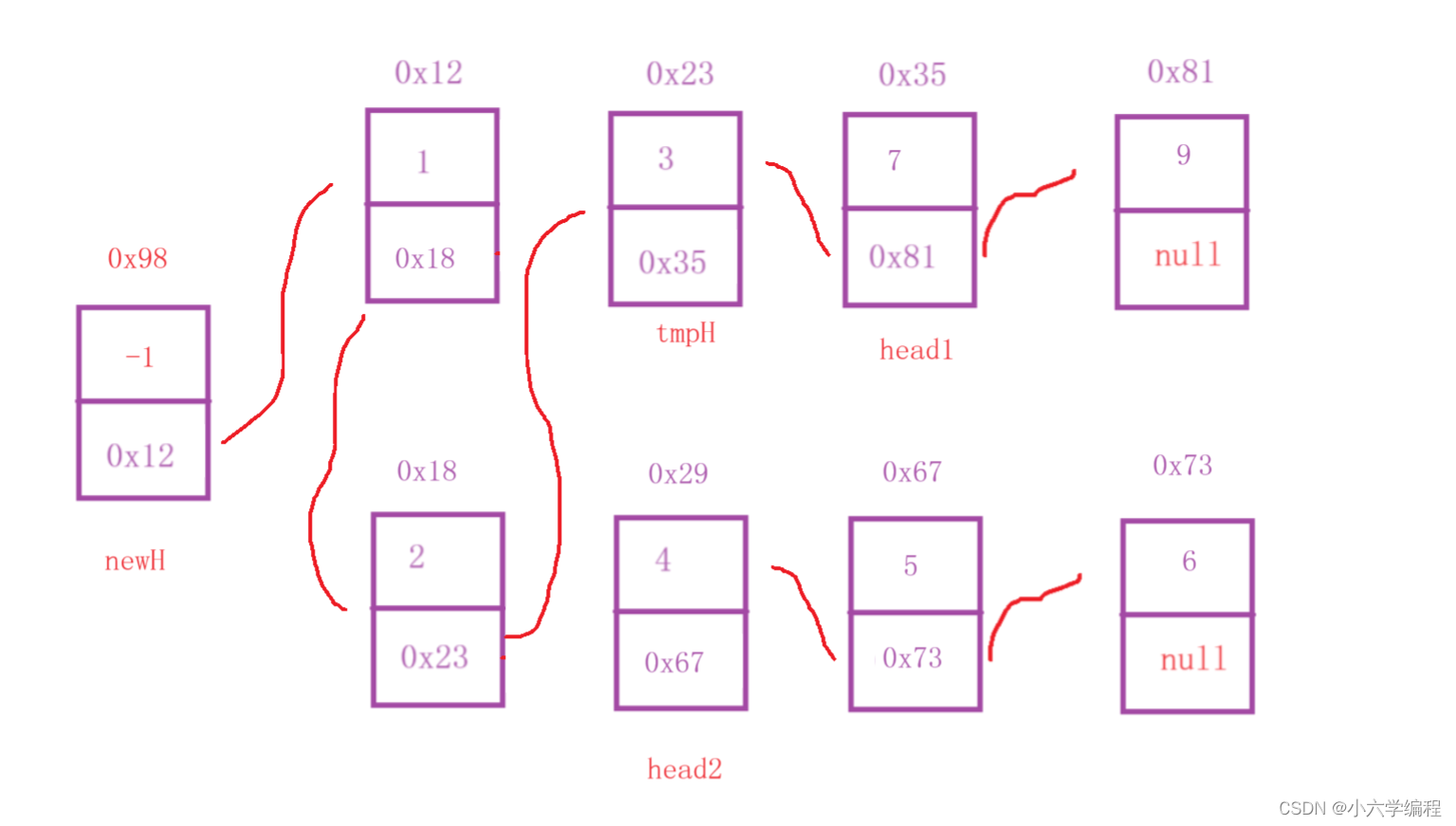
继续比较
head2.val更小

……
当其中有一个数组比较完了的时候,此时只需令tmpH.next为另一个head即可
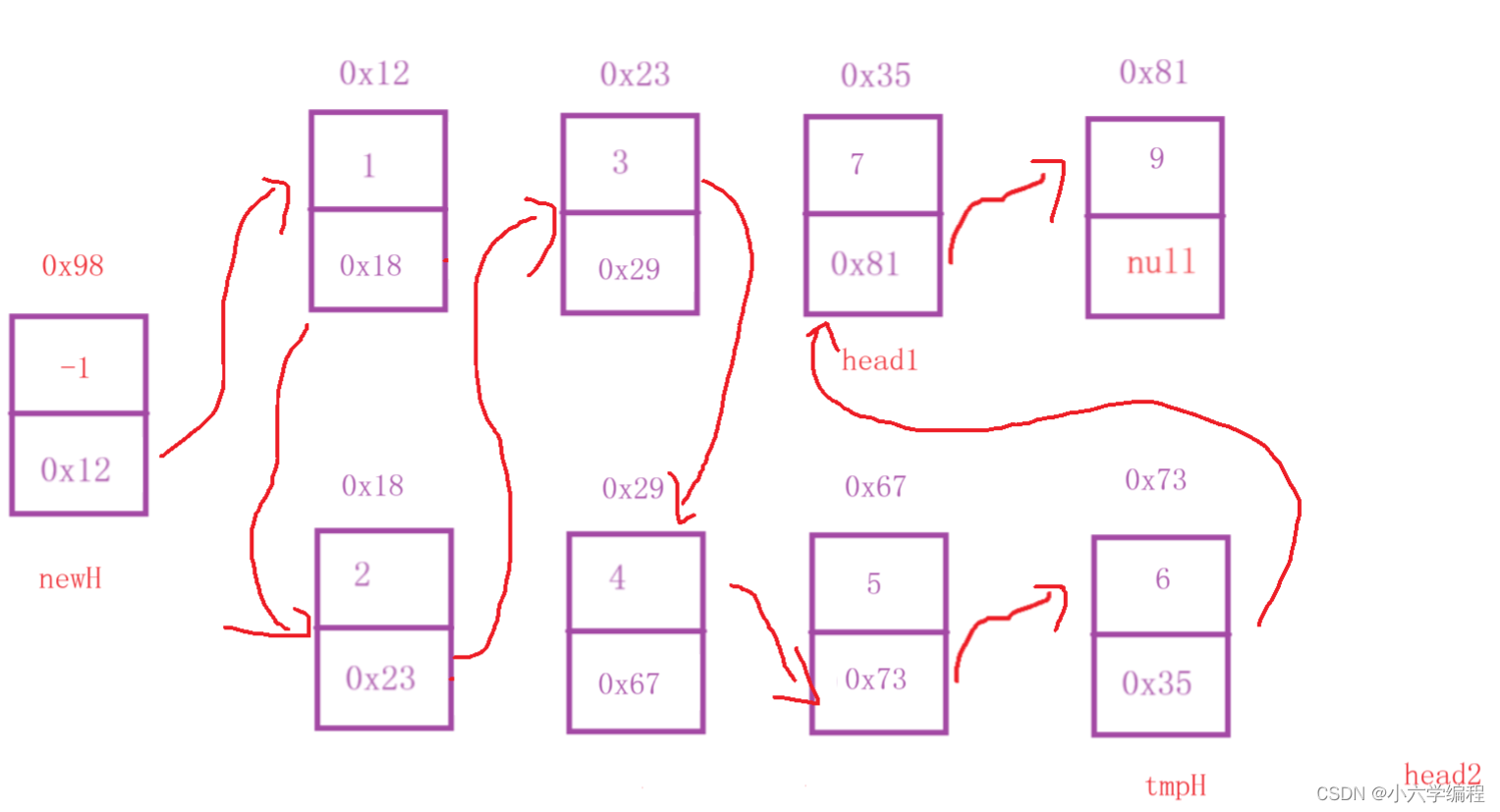
最后返回newH.next即可
class Solution {
public ListNode mergeTwoLists(ListNode head1, ListNode head2) {
ListNode newH = new ListNode(-1);
ListNode tmpH = newH;
while (head1 != null && head2 != null) {
if (head1.val < head2.val) {
tmpH.next = head1;
tmpH = tmpH.next;
head1 = head1.next;
} else {
tmpH.next = head2;
tmpH = tmpH.next;
head2 = head2.next;
}
}
if (head1 != null) {
tmpH.next = head1;
}
if (head2 != null) {
tmpH.next = head2;
}
return newH.next;
}
}6.编写代码,以给定值x为基准将链表分割成两部分,所有小于x的结点排在大于或等于x的结点之前
使用cur遍历顺序表
当cur.val<给定的值x时就让它进入链表1
当cur.val>=给定的值x时就让它进入链表2
最后将链表2的尾部插在链表1的头部,返回链表2
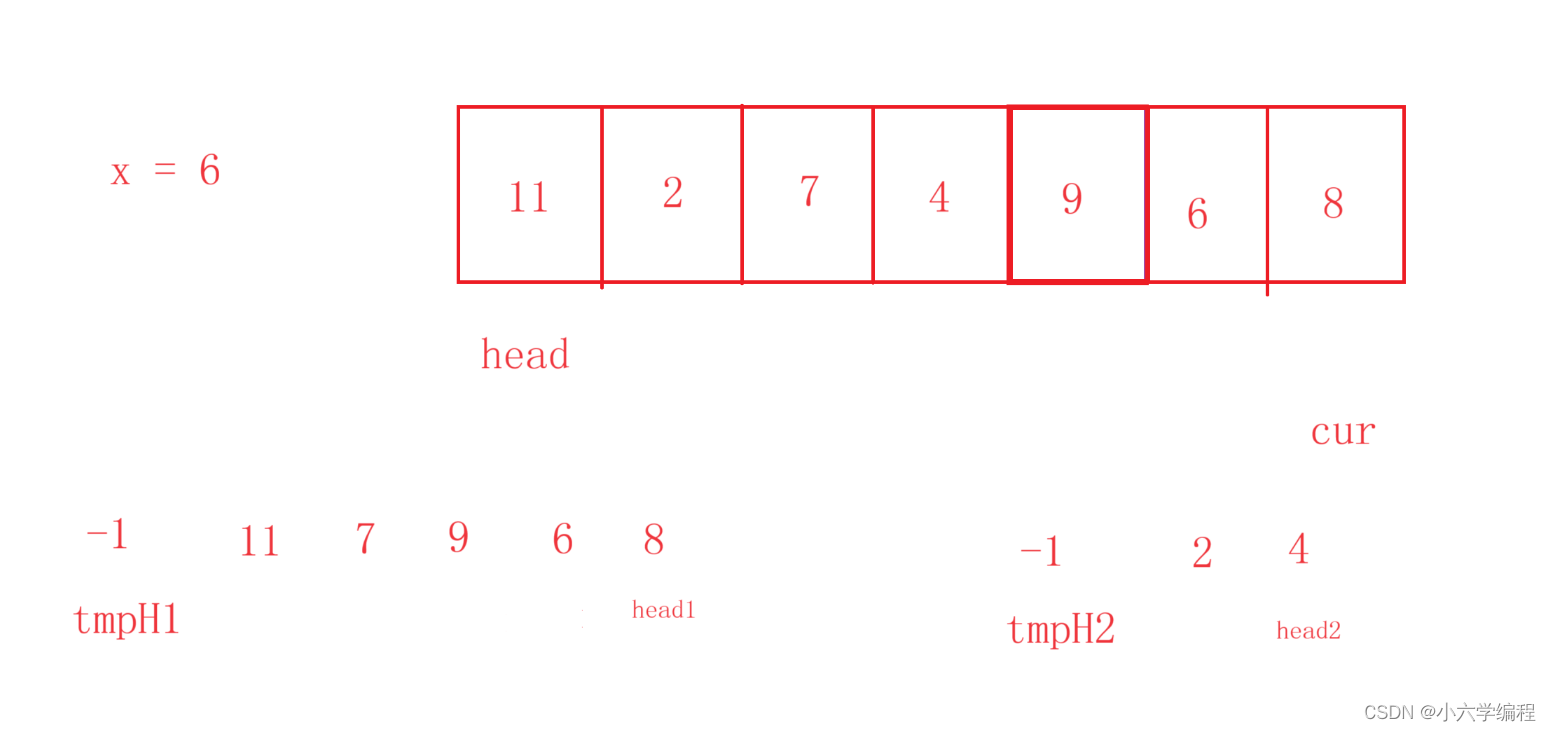
public class Partition {
public ListNode partition(ListNode pHead, int x) {
ListNode cur = pHead;
ListNode tmpH1 = new ListNode(-1);
ListNode tmpH2 = new ListNode(-1);
ListNode head1 = tmpH1;
ListNode head2 = tmpH2;
while (cur != null) {
if (cur.val < x) {
head2.next = cur;
head2 = head2.next;
} else {
head1.next = cur;
head1 = head1.next;
}
cur = cur.next;
}
tmpH2 = tmpH2.next;
tmpH1 = tmpH1.next;
head2.next = tmpH1;
head1.next = null;
if (tmpH2 == null) {
return tmpH1;
}
if (tmpH1 == null) {
return tmpH2;
}
return tmpH2;
}
}7.链表的回文结构
通过以上快慢指针的方式找到链表的中间节点
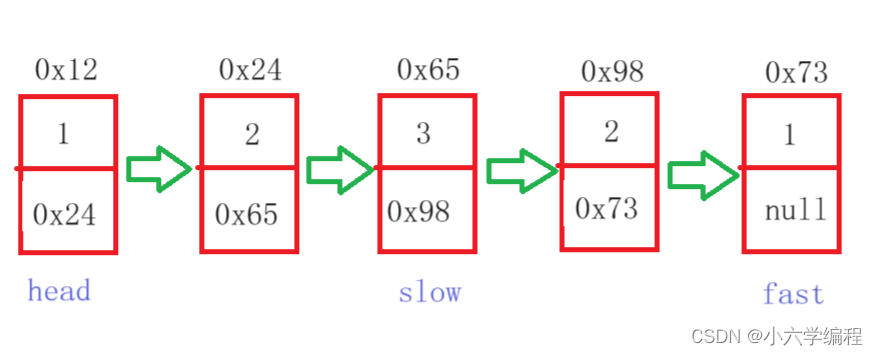
翻转

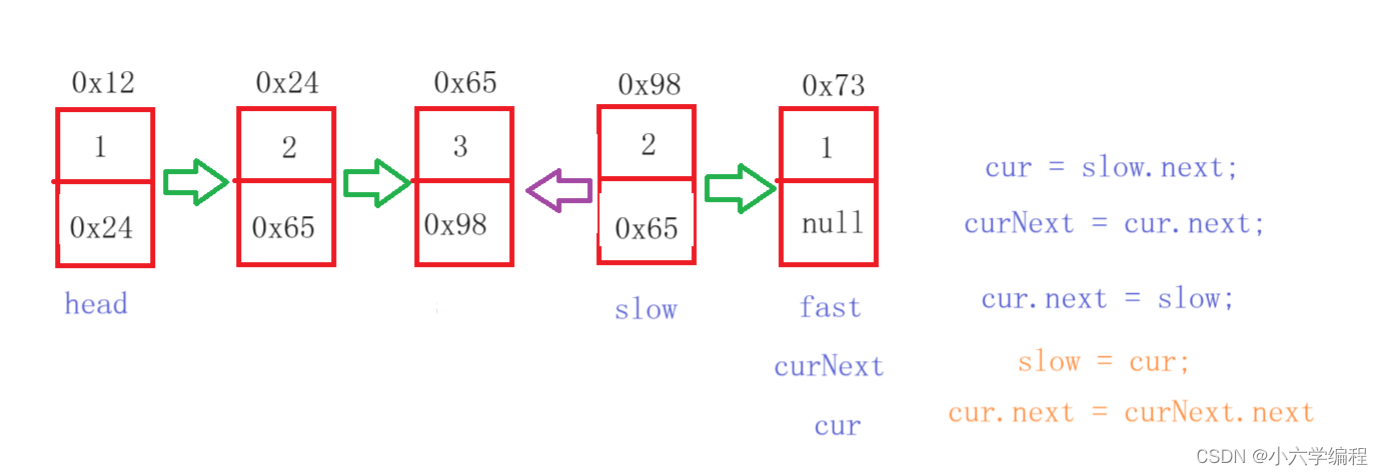
当slow和fast相遇时停止
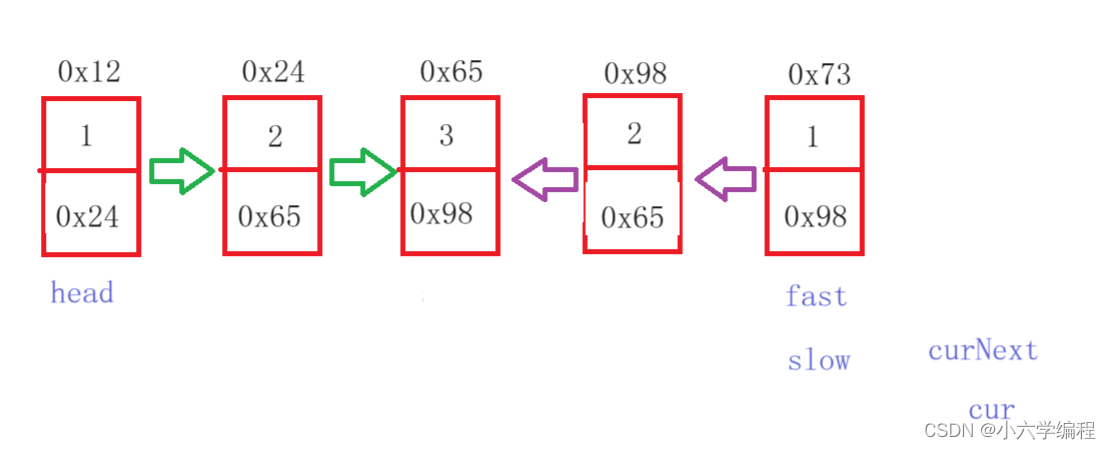
public class PalindromeList {
public boolean chkPalindrome(ListNode A) {
if (A == null || A.next == null) {
return true;
}
ListNode fast = A;
ListNode slow = A;
//找中间位置
while (fast != null && fast.next != null) {
fast = fast.next.next;
slow = slow.next;
}
ListNode cur = slow.next;
//翻转
while (cur != null) {
ListNode curNext = cur.next;
cur.next = slow;
slow = cur;
cur = curNext;
}
ListNode right = slow;
ListNode left = A;
//从前到后 从后到前
while (left.next != right.next ) {
if (left.val != right.val) {
return false;
}
if (left.next == right)
{
return true;
}
left = left.next;
right = right.next;
}
return true;
}
}

